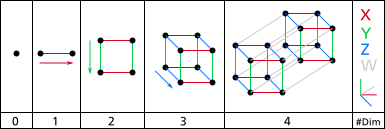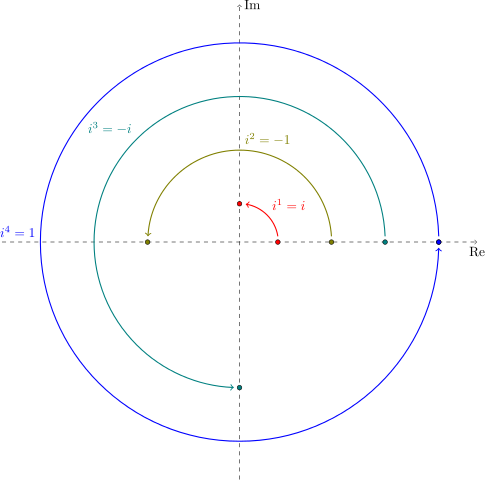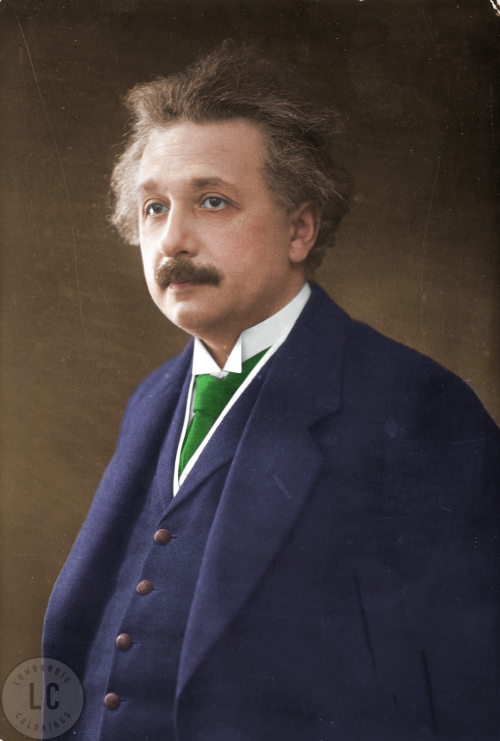#theoretical physics
Beyond the Enlightenment Rationalists:
From imaginary to probable numbers - II

(continued from here)
When a geometric interpretation of imaginary numbers was at last proposed, long after they were invented, it was as though accomplished by central committee. The upshot was easily enough understood but also simplistic. In broad brushstroke here is what seems to have gone down.
The 3 dimensions of Descartes’ coordinate system-a number already deficient from the perspective of mandalic geometry-were reduced to just one. Of the real number axes then only the x-axis remained. This meant from the get-go that any geometric figure that ensued could encompass only linearity in terms of real numbers and dimensions. It was applicable only to a line segment, so the complex plane that resulted could describe just one real dimension and one imaginary dimension. It consecrated the number line in a single dimension, to exclusion of its proper habitation in two others besides. Strike one for imaginary numbers.[1]
With that as background let’s look now at the rotations described by this geometric interpretation of imaginary numbers in the context of the complex plane.

i in the complex or cartesian plane. Real numbers lie on the horizontal axis, and imaginary numbers lie on the vertical axis By Loadmaster (David R. Tribble) (Own work) [CC BY-SA 3.0orGFDL],via Wikimedia Commons
The number 1 is the multiplicative identity element for real numbers and the number -1 is the reflection inversion element for real numbers. Put another way, the number one times any number equals that number; the number -1 times any number is a negative of that number or the inverse number through a reference point, usually taken as zero. Multiplying by 1 then leaves 1, -1, i and -i all unchanged. Multiplying by -1 changes -1 to 1, 1 to -1, i to -i, and -i to i. In terms of rotations in the complex plane, these changes all involve a rotation through 180 degrees. Multiplication of the number 1 by i changes it to i; i by i changes it to -1; -1 by i to -i; and -i by i to 1. These changes all involve rotations through 90 degrees. And finally, multiplication of 1 by -i changes it to -i; -i by -i changes it to -1; -1 by -i to i; and i by -i to 1: all changes involving rotations through -90 degrees.
The figure below shows another way to interpret these rotations that amounts to the same tbing: i1 = i; i2 =-1; i3 = -i; i4 = 1. Click to enlarge.

Four numbers on the real line multiplied by integer powers of the imaginary unit, which corresponds to rotations by multiples of the right angle. By Keφr [CC0],via Wikimedia Commons
I think a committee of some sort must have come up with this resplendent plan. For certain it was an Academy of Mathematics and Sciences that endorsed and enthroned it. All bow to central authority.
I had planned to include a comparison of imaginary numbers and probable numbers in this post as well but because that is a long discussion itself, it will have to wait till the next post. I might add it should prove well worth the wait.
(continuedhere)
Image: A drawing of the first four dimensions. On the left is zero dimensions (a point) and on the right is four dimensions (A tesseract). There is an axis and labels on the right and which level of dimensions it is on the bottom. The arrows alongside the shapes indicate the direction of extrusion. By NerdBoy1392 (Own work) [CC BY-SA 3.0orGFDL],via Wikimedia Commons
Notes
[1] Mathematician William Rowan Hamilton subsequently addressed this deficiency in 1843 with his quaternions, a number system that extends the complex numbers to three-dimensional space. Hamilton defined a quaternion as the quotient of two directed lines in a three-dimensional space or, in other words, as the quotient of two vectors. This complicated matters even more by introducing a non-commutative multiplication operation to the system, though to be fair the quaternion coordinate system has found some useful applications mainly for calculations involving 3-dimensional rotations, as in 3-dimensional computer graphics,computer vision, and crystallographic texture analysis. Still it becomes problematic when theoretical physics attempts use of quaternions in calculations pertaining to atomic and subatomic spaces where rotations do not actually take place. The conclusion to be drawn here is that quaternions can be usefully, if somewhat clumsily, applied to 3-dimensional macro-spaces but are inapproriate for accurate description of higher dimensional spaces. What is here unfortunate and misleading is that quaternions apparently do describe outcomes of events in the quantum realm to some partial degree, if not the mechanisms of the events themselves. Physicists would not long tolerate them were that not so.
[ADDENDUM (24 APRIL, 2016)
Since writing this I’ve learned that quaternions are not currently used in quantum physics nor were they ever, to any great degree, in the past.]
In other words, sometimes the right answer can be reached by a wrong method. In the case under discussion here, we should note that it is possible for a rotation to mimic inversion (reflection through a point). A 90° rotation in two dimensions can mimic a single inversion in a single plane through an edge of a square, and a 180° rotation in two dimensions can mimic a single inversion through a diagonal of a square or two successive inversions through two perpendicular edges of a square. A 180° rotation in three dimensions can mimic three inversions through three mutually perpendicular edges of a square; a combination of one inversion through a diagonal of a square and another through an edge perpendicular to the plane of the first inversion; or a single inversion through a diagonal of the cube. Subatomic paricles exist as discrete or quantized entities and would follow such methods of transformation rather than rotations through a continuous space. Of course, transformations involving a diagonal would require more transformative energy than one involving a single edge.
Such patterns of relationship and transformation could no doubt be described in terms of quantum states and quantum numbers without too much difficulty by a knowledgeable theoretical physicist. Surely doing so could be no more difficult than using quaternions, which may give a correct answer while also misleading and limiting knowledge of the the true workings of the quantum realm by using an incorrect mechanism, one non-commutative to boot. Nature doesn’t approve of hat tricks like that.
© 2016 Martin Hauser
Please note: The content and/or format of this post may not be in finalized form. Reblog as a TEXT post will contain this caveat alerting readers to refer to the current version in the source blog. A LINK post will itself do the same. :)
Scroll to bottom for links to Previous / Next pages (if existent). This blog builds on what came before so the best way to follow it is chronologically. Tumblr doesn’t make that easy to do. Since the most recent page is reckoned as Page 1 the number of the actual Page 1 continually changes as new posts are added. To determine the number currently needed to locate Page 1 go to the most recent post which is here. The current total number of pages in the blog will be found at the bottom. The true Page 1 can be reached by changing the web address mandalicgeometry.tumblr.com to mandalicgeometry.tumblr.com/page/x, exchanging my current page number for x and entering. To find a different true page(p) subtract p from x+1 to get the number(n) to use. Place n in the URL instead of x (mandalicgeometry.tumblr.com/page/n) where
n = x + 1 - p. :)
-Page 307-
A controversial new gravity hypothesis has passed its first test
Einstein might have been wrong.
By Fiona MacDonald
A controversial new hypothesis that suggests our understanding of gravity is wrong has just passed an important first test.
First proposed back in 2010, the new hypothesis states that gravity might behave and arise very differently than Einstein predicted, and an independent study of more than 30,000 galaxies has now found the first evidence to back this up.
Post link
Lawrence Krauss on “Seeing” the Early Universe
At a 2016 convention hosted by the Committee for Skeptical Inquiry, theoretical physicist Lawrence M. Krauss spoke about scientists’ attempts to look back to when the universe was just fractions of a second old. A few highlights from Krauss’ talk are listed below, and his full presentation can be seen at the bottom of this article.
Post link
Taming the multiverse: Stephen Hawking’s final theory about the big bang
Professor Stephen Hawking’s final theory on the origin of the universe, which he worked on in collaboration with Professor Thomas Hertog from KU Leuven, has been published today in the Journal of High Energy Physics.
The theory, which was submitted for publication before Hawking’s death earlier this year, is based on string theory and predicts the universe is finite and far simpler than many current theories about the big bang say.
Professor Hertog, whose work has been supported by the European Research Council, first announced the new theory at a conference at the University of Cambridge in July of last year, organised on the occasion of Professor Hawking’s 75thbirthday.
Modern theories of the big bang predict that our local universe came into existence with a brief burst of inflation – in other words, a tiny fraction of a second after the big bang itself, the universe expanded at an exponential rate. It is widely believed, however, that once inflation starts, there are regions where it never stops. It is thought that quantum effects can keep inflation going forever in some regions of the universe so that globally, inflation is eternal. The observable part of our universe would then be just a hospitable pocket universe, a region in which inflation has ended and stars and galaxies formed.
“The usual theory of eternal inflation predicts that globally our universe is like an infinite fractal, with a mosaic of different pocket universes, separated by an inflating ocean,” said Hawking in an interview last autumn. “The local laws of physics and chemistry can differ from one pocket universe to another, which together would form a multiverse. But I have never been a fan of the multiverse. If the scale of different universes in the multiverse is large or infinite the theory can’t be tested. ”
In their new paper, Hawking and Hertog say this account of eternal inflation as a theory of the big bang is wrong. “The problem with the usual account of eternal inflation is that it assumes an existing background universe that evolves according to Einstein’s theory of general relativity and treats the quantum effects as small fluctuations around this,” said Hertog. “However, the dynamics of eternal inflation wipes out the separation between classical and quantum physics. As a consequence, Einstein’s theory breaks down in eternal inflation.”
“We predict that our universe, on the largest scales, is reasonably smooth and globally finite. So it is not a fractal structure,” said Hawking.
The theory of eternal inflation that Hawking and Hertog put forward is based on string theory: a branch of theoretical physics that attempts to reconcile gravity and general relativity with quantum physics, in part by describing the fundamental constituents of the universe as tiny vibrating strings. Their approach uses the string theory concept of holography, which postulates that the universe is a large and complex hologram: physical reality in certain 3D spaces can be mathematically reduced to 2D projections on a surface.
Hawking and Hertog developed a variation of this concept of holography to project out the time dimension in eternal inflation. This enabled them to describe eternal inflation without having to rely on Einstein’ theory. In the new theory, eternal inflation is reduced to a timeless state defined on a spatial surface at the beginning of time.
“When we trace the evolution of our universe backwards in time, at some point we arrive at the threshold of eternal inflation, where our familiar notion of time ceases to have any meaning,” said Hertog.
Hawking’s earlier ‘no boundary theory’ predicted that if you go back in time to the beginning of the universe, the universe shrinks and closes off like a sphere, but this new theory represents a step away from the earlier work. “Now we’re saying that there is a boundary in our past,” said Hertog.
Hertog and Hawking used their new theory to derive more reliable predictions about the global structure of the universe. They predicted the universe that emerges from eternal inflation on the past boundary is finite and far simpler than the infinite fractal structure predicted by the old theory of eternal inflation.
Their results, if confirmed by further work, would have far-reaching implications for the multiverse paradigm. “We are not down to a single, unique universe, but our findings imply a significant reduction of the multiverse, to a much smaller range of possible universes,” said Hawking.
This makes the theory more predictive and testable.
Hertog now plans to study the implications of the new theory on smaller scales that are within reach of our space telescopes. He believes that primordial gravitational waves – ripples in spacetime – generated at the exit from eternal inflation constitute the most promising “smoking gun” to test the model. The expansion of our universe since the beginning means such gravitational waves would have very long wavelengths, outside the range of the current LIGO detectors. But they might be heard by the planned European space-based gravitational wave observatory, LISA, or seen in future experiments measuring the cosmic microwave background.
Reference:
S.W. Hawking and Thomas Hertog. ‘A Smooth Exit from Eternal Inflation?’’ Journal of High-Energy Physics (2018). DOI: 10.1007/JHEP04(2018)147
Post link
Photographer unknown, perhaps c. 1920.
Colored by Lombardie Colorings.
________________________________________________________________
Post link
The neutrino is sometimes called the ghost particle, because it can penetrate entire planets and stars without being absorbed. At this very instant, your body is being radiated by a flood of neutrinos from deep space, some of which traveled through the entire planet Earth. In fact, some of these neutrinos could penetrate a block of solid lead that stretches from the Earth to the nearest star.
The God Equation: The Quest for a Theory of Everything - Michio Kaku
Throughout history, scientists and philosophers believed that there was some sort of life force that animated living things. When a mysterious soul entered a body, it suddenly became animate and acted human. Many believed in something called dualism, where the material body coexisted with a spiritual soul.
Schrödinger, however, believed that the code of life was hidden inside some master molecule that obeyed the laws of quantum mechanics. Einstein, for example, banished the ether from physics. Likewise, Schrödinger would try to banish the life force from biology.
The God Equation: The Quest for a Theory of Everything, Michio Kaku
The origin of the universe has also fascinated physicists, especially when Newton gave us a compelling theory of gravity. But when Newton tried to apply his theory to the universe we see around us, he encountered problems.
In 1692, he received a disturbing letter from clergyman Richard Bentley. In the letter, Bentley asked Newton to explain a hidden, possibly damaging flaw in his theory. If the universe is finite, and if gravity is always attractive, rather than repulsive, then eventually all the stars in the universe will be attracted to one another. In fact, with enough time, they will all coalesce into a single, gigantic star. So a finite universe should be unstable, and must eventually collapse. Since this does not happen, there must be a flaw in Newton’s theory.
Next, he argued that Newton’s laws predicted an unstable universe even if the universe were infinite. In an infinite universe, with an infinite number of stars, the sum of all forces tugging on a star from the left and right would also be infinite. Hence, these infinite forces would eventually tear the stars apart, and hence all stars would disintegrate.
Newton was disturbed by this letter, because he had not considered applying his theory to the entire universe. Eventually, Newton came up with a clever but incomplete answer to this question.
Yes, he admitted, if gravity is always attractive, and never repulsive, then the stars in the universe might be unstable. But there was a loophole in this argument. Assume that the universe is, on average, totally uniform and infinite in all directions. In such a static universe, all the forces of gravity cancel one another out, and the universe becomes stable once again. Given any star, the forces of gravity acting on it from all the distant stars in different directions eventually sum to zero, and hence the universe does not collapse.
Although this was a clever solution to this problem, Newton realized there was still a potential flaw to his solution. The universe might be uniform on average, but it cannot be exactly uniform at all points, so there must be tiny deviations. Like a house of cards, it appears to be stable, but the tiniest flaw will cause the entire structure to collapse. So Newton was clever enough to realize that a uniform infinite universe was indeed stable but was always teetering on the edge of collapse. In other words, the cancellation of infinite forces must be infinitely precise or else the universe will either collapse or be ripped apart.
Thus, Newton’s final conclusion was that the universe was infinite and uniform on average, but occasionally God has to tweak the stars in the universe, so they do not collapse under gravity.
The God Equation: The Quest for a Theory of Everything - Michio Kaku
Trillions upon trillions of years from now, the stars of the universe will have exhausted all their nuclear fuel and become dark. Only black holes will survive in this bleak era. But even black holes must eventually evaporate, leaving nothing but a drifting sea of subatomic particles. Hawking asked himself another question: What happens if you throw a book into a black hole? Is the information in that book lost forever?
According to quantum mechanics, information is never lost. Even if you burn a book, by tediously analyzing the molecules of the burned paper, it’s possible to reconstruct the entire book.
But Hawking stirred up a hornet’s nest of controversy by saying that information thrown inside a black hole is indeed lost forever, and that quantum mechanics therefore breaks down in a black hole.
As previously mentioned, Einstein once said that “God does not play dice with the world”—that is, you cannot reduce everything to chance and uncertainty. Hawking added, “Sometimes God throws the die where you cannot find them,” meaning that the dice may land inside a black hole, where the laws of the quantum may not hold. So the laws of uncertainty fail when you go past the event horizon.
Since then, other physicists have come to the defense of quantum mechanics, showing that advanced theories like string theory, which we will discuss in the next chapter, can preserve information even in the presence of black holes. Eventually, Hawking conceded that perhaps he was wrong. But he proposed his own novel solution. Perhaps when you throw a book into a black hole, the information is not lost forever, as he previously thought, but it comes back out, in the form of Hawking radiation. Encoded within the faint Hawking radiation is all the information necessary to re-create the original book.
whether information is lost in a black hole is still an ongoing question, fiercely debated among physicists. But ultimately we may have to wait until we have the final quantum theory of gravity that includes graviton quantum corrections.
The God Equation: The Quest for a Theory of Everything - Michio Kaku
The black hole that was photographed by the Event Horizon Telescope lies inside the galaxy M87, 53 million light-years from Earth. The black hole is truly a monster, weighing in at a staggering five billion times the mass of the sun. Our entire solar system, even past Pluto, could easily fit inside the black silhouette in the photograph.
The God Equation: The Quest for a Theory of Everything - Michio Kaku
It would take another two hundred years for the next big breakthrough, which came from the study of electricityandmagnetism.
The ancients had known that magnetism could be tamed; the invention of the compass by the Chinese harnessed the power of magnetism and helped launch an age of discovery. But the ancients feared the power of electricity. Lightning bolts were thought to express the anger of the gods.
The man who finally laid the foundation for this field was Michael Faraday, a poor but industrious youth who lacked any formal education. As a child, he managed to get a job working as an assistant at the Royal Institution in London. Normally, someone of his low social standing would forever sweep the floor, wash bottles, and hide in the shadows. But this young man was so tireless and inquisitive that his supervisors allowed him to perform experiments.
Faraday would go on to make some of the greatest discoveries in electricity and magnetism.
- He showed that if you take a magnet and move it inside a hoop of wire, then electricity is generated in the wire.
- One could also show the reverse, that a moving electric field can create a magnetic one.
- This was an amazing and important observation, since the relationship between electricity and magnetism was then totally unknown.
It gradually dawned on Faraday that these two phenomena were actually two sides of the same coin. This simple observation would help to open up the electric age.
He also invented the concept of a field, one of the most important concepts in all of physics.
- A field consists of these lines of force spread throughout space. Magnetic lines surround every magnet, and the magnetic field of the Earth emanates from the north pole, spreads through space, and then returns to the south pole.
- Even Newton’s theory of gravity can be expressed in terms of fields, so that the Earth moves around the sun because it moves in the sun’s gravitational field.
Faraday’s discovery helped to explain the origin of the magnetic field surrounding the Earth.
- Since the Earth spins, the electric charges inside the Earth also spin.
- This constant motion moving inside the Earth is responsible for the magnetic field. (But this still left open a mystery: Where does the magnetic field of a bar magnet come from, since there is nothing moving or spinning in it? We will return to this mystery later.)
Today, all the known forces of the universe are expressed in the language of fields first introduced by Faraday.
The God Equation: The Quest for a Theory of Everything by Michio Kaku




